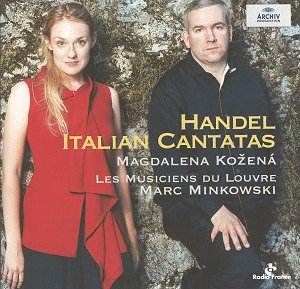George Frideric HANDEL
Italian Cantatas
Delirio amaroso: "Da quel giorno fatale", HWV99
La Lucrezia: "O Numi eterni!", HWV 145
"Tra le fiamme", HWV 170
 Magdalena Kozená,
mezzo-soprano
Magdalena Kozená,
mezzo-soprano
Les Musiciens du Louvre
directed by Marc Minkowski
 DG Archiv 469
065 2 [67:42]
DG Archiv 469
065 2 [67:42]
Crotchet
AmazonUS

The three Italian cantatas on this album were composed while the young Handel
was in Rome in the early years of the 18th century. They were
probably written for private performances in various palaces, the first and
last most likely to texts by cardinal Pamphili. From John Mainwaring's 1760
biography we know the composer was "much and often" at the cardinal's palace,
who "had some talents for Poetry and wrote the drama of Il Trionfo del
Tempo, besides several other pieces, which Handel set at his desire."
Copies of both cantata texts exist in the cardinal's archive.
Da quel giorno fatale appears to date from late 1706 or early the
next year, and seems to be the first major work Handel wrote in Rome. It
is certainly a substantial work in every sense, at 34 minutes, being longer
than the other two works combined. In an Arcadian fantasy Clori searches
for her lover, Tirsi, her quest taking her to Elysium via a sequence of elegantly
crafted arias. Half the length and twice as intense is O Numi eterni.
Musically more intimate than the preceding work, harpsichord continuo is
added and the recitative is emphasised more between the passionately committed
arias. Probably dating from 1708, the work is a dramatisation of the story
of Lucrezia we know from Shakespeare. The sheer commitment of "Il suol che
preme" and the melancholy beauty of "Già nel seno comincia a compir"
stand out before the appropriately titled Furioso, "Ma se qui non m'è
dato".
Tra le Fiamme, inspired by the legend of Daedalus and Icarus, was
written between the two previous works, most likely in 1707. There are three
arias and Da Capo, with some eloquent viola da gamba playing from Juan-Manuel
Quintana. The opening, title aria, has a considerable extended beauty, with
some lovely flowing lines. The second aria, "Pien di nuovo e bel diletto"
is much more a vocal showcase, giving Magdalena Kozená the opportunity
to display her flamboyance. A rapidly rising star of the early music world,
she has a clear, light voice which compares with the young Emma Kirkby.
Kozená is a little more detached, but her musicianship is beyond doubt.
Marc Minkowski meanwhile ensures period authenticity and formal grace from
his own ensemble, Les Musiciens du Louvre.
Anyone who enjoyed Kirkby's programme of Handel's Italian cantatas recorded
with Christopher Hogwood and the Academy of Ancient Music in 1986 (L'Oiseau-Lyre
414 473-2OH) - a set which includes the last of the three cantatas on this
present release - will find much that is rewarding, extending to the beautifully
designed and thoroughly documented booklet. I doubt anyone buying this album
will be disappointed, however, if you are only to have one disc the
Kirkby/Hogwood remains the preferred choice.
Gary S. Dalkin


